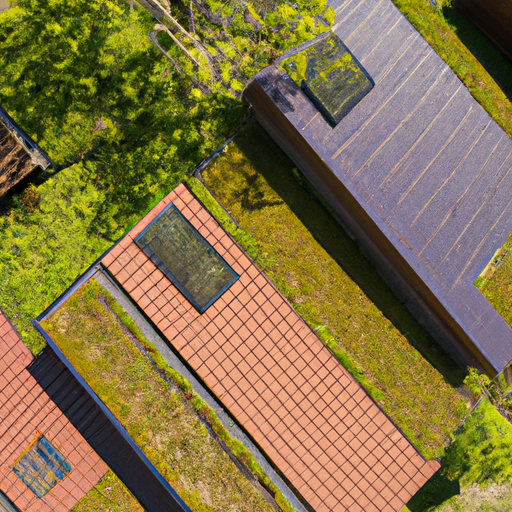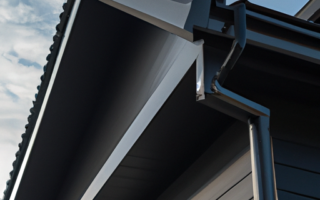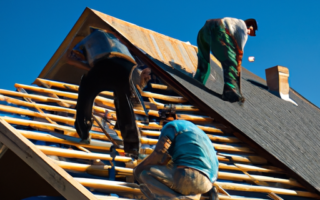Types of Roof Construction Techniques: A Comprehensive Guide
When it comes to constructing a roof, there are various techniques that can be used, each with its own set of advantages and considerations. In this comprehensive guide, we will explore different types of roof construction techniques, taking into account their key features and applications.
1. Pitched Roof Construction:
Pitched roof construction is a popular choice for residential buildings. This type of roof features a steep slope and typically consists of trusses or rafters that support the weight of the roof. Pitched roofs offer excellent water drainage and can accommodate various roofing materials such as asphalt shingles, clay tiles, or metal roofing sheets. They are known for their durability and long lifespan.
2. Flat Roof Construction:
Flat roof construction is commonly seen in commercial and industrial buildings. As the name suggests, this type of roof has a low slope or no slope at all, making it easier to install and maintain. Flat roofs often utilize a waterproofing membrane that prevents water infiltration. They are cost-effective, provide additional usable space for HVAC units or solar panels, and can be used as rooftop gardens or recreational areas.
3. Green Roof Construction:
Green roof construction involves the installation of vegetation layers on top of a roof. This environmentally-friendly approach provides numerous benefits, including improved insulation, reduced urban heat island effect, and enhanced stormwater management. Green roofs can be extensive, featuring low-maintenance plants like sedums, or intensive, supporting a wider range of vegetation types. The construction process requires additional structural support and waterproofing measures.
4. Domed Roof Construction:
Domed roofs are characterized by their rounded shape, creating a striking architectural statement. Traditionally, domed roofs were constructed using materials such as clay or stone, but modern techniques now incorporate materials like metal or glass. Domed roofs provide excellent structural strength, maximizing interior space and offering superior resistance to extreme weather conditions. They are commonly found in religious and historical buildings, but can also be used in contemporary architecture.
These are just a few examples of the wide range of roof construction techniques available. Other notable techniques include gable roofs, hip roofs, and mansard roofs, each with its own unique characteristics and applications. When choosing a roof construction technique, it is important to consider factors such as climate, building design, budget, and local regulations. Consulting with a professional roofing contractor can help ensure the best choice for your specific project.
By exploring and understanding the various types of roof construction techniques, you can make an informed decision, selecting the method that aligns with your needs and requirements. Whether it’s a pitched roof for your home or a green roof for an eco-friendly building, the right roof construction technique can contribute to the overall functionality, durability, and aesthetics of the structure.
Traditional Roofing Methods: Exploring Timeless Techniques for Building Strong Roofs
When it comes to roof construction, there are various techniques used depending on factors such as climate, architectural style, and materials. While modern roofing methods have their advantages, traditional roofing techniques have stood the test of time and continue to be used in many regions around the world.
Traditional roof construction methods are known for their durability and ability to withstand harsh weather conditions. In areas prone to high winds, heavy rains, or extreme temperatures, these techniques have proven to be reliable and long-lasting.
One of the most common traditional roofing methods is the use of natural materials such as slate, clay tiles, or thatch. These materials are not only aesthetically pleasing but also offer excellent insulation and durability. Slate, for example, is known for its ability to resist fire and its resistance to fading or weathering over time.
Another traditional roofing technique is the use of timber frames and beams. This method is often used in areas with abundant timber resources and has been used for centuries. Timber frames provide a strong and sturdy structure for the roof and can withstand heavy loads. Additionally, timber is a renewable resource, making it an environmentally friendly choice.
In addition to the materials used, traditional roof construction techniques also include specific installation methods. For example, the „long straw” thatching technique involves layering straw bundles over a wooden framework, providing a dense and insulating roof covering. Thatched roofs are not only visually striking but also provide excellent protection against the elements.
It is important to note that while traditional roofing methods have their advantages, they may not be suitable for all climates or building styles. Regions with high humidity, for instance, may require more modern materials and ventilation systems to prevent mold and rot. Additionally, certain architectural styles may call for innovative roofing approaches that blend traditional aesthetics with contemporary engineering.
In conclusion, traditional roof construction techniques offer a timeless and proven approach to building strong and durable roofs. These methods have been refined over centuries and continue to be used in many parts of the world. Whether it’s the use of natural materials like slate or thatch, or the incorporation of timber frames, traditional roofing techniques are a testament to the ingenuity of our ancestors and the adaptability of these time-honored practices.
Modern Innovations in Roof Construction: From Green Roofs to Prefabricated Solutions
Roof construction techniques have evolved significantly over the years, thanks to modern innovations and advancements in technology. Today, there are various types of roof construction techniques, each offering unique benefits and addressing specific needs. In this article, we will explore some of the modern innovations in roof construction, including green roofs and prefabricated solutions.
Green roofs, also known as living roofs or eco-roofs, are becoming increasingly popular among environmentally-conscious homeowners and building developers. These roofs feature a layer of vegetation, which provides a range of benefits. Firstly, green roofs act as natural insulators, reducing the heating and cooling needs of a building. By absorbing and utilizing rainwater, they also help with stormwater management, reducing the strain on drainage systems. Green roofs also improve air quality by absorbing carbon dioxide and releasing oxygen, mitigating the impact of urban heat islands, and providing habitats for various species.
Another modern innovation in roof construction is the use of prefabricated solutions. Prefabricated roofs, also known as modular roofs, are built off-site and then transported to the construction site for installation. This method offers several advantages, including reduced construction time and labor costs. Prefabricated roofs are designed and manufactured in controlled environments, ensuring consistent quality. They are also highly customizable, allowing for flexibility in design and architecture. Additionally, prefabricated roofs are typically lighter and easier to install, making them suitable for a wide range of projects.
In recent years, there has also been a growing trend towards the use of sustainable materials in roof construction. Traditional roofing materials, such as asphalt shingles and concrete tiles, are being replaced by more eco-friendly alternatives. Materials like metal roofing, which can be made from recycled materials and are highly durable, are gaining popularity. There is also a rising demand for solar panels, which can be seamlessly integrated into roofing systems to generate clean, renewable energy.
With the constant advancements in technology and the increasing focus on sustainability, the future of roof construction is likely to see even more innovative solutions. From smart roofing systems that can monitor and adjust their performance to the use of 3D printing technology for customized roof designs, the possibilities are endless. These modern innovations not only enhance the functionality and efficiency of roofs but also contribute to a more sustainable and eco-friendly built environment.
In conclusion, modern innovations in roof construction have revolutionized the industry, offering a range of benefits including energy efficiency, environmental sustainability, and cost-effectiveness. With the rise of green roofs, prefabricated solutions, and sustainable materials, homeowners and building developers now have access to a diverse range of options when it comes to constructing or renovating their roofs. As technology continues to advance, we can expect even more exciting and eco-friendly developments in the field of roof construction.
Exploring Alternative Roofing Techniques: Unconventional Methods for a Unique and Durable Roof
When it comes to roof construction techniques, there is a wide variety of conventional methods that have been used for years. However, for those looking for a unique and durable roof, exploring alternative roofing techniques can be a great option. These unconventional methods offer not only a distinctive aesthetic appeal but also improved functionality and longevity.
One unconventional roofing technique worth exploring is the living roof or green roof. This method involves covering the roof with vegetation, creating a natural and eco-friendly surface. Green roofs offer a range of benefits, including insulation, stormwater management, and improved air quality. They can also help reduce energy consumption by providing natural cooling in the summer and insulation in the winter.
Another alternative roofing technique is solar roof installation. With the increasing popularity of renewable energy sources, solar roofs have become a viable option for homeowners. Solar panels are integrated into the roof, allowing the generation of electricity from the sun’s energy. These roofs not only provide durable protection but also help reduce energy costs and carbon footprint.
For those seeking a visually striking roof, the use of reclaimed materials can create a unique and sustainable solution. Reclaimed materials, such as reclaimed wood or metal, add character and charm to a roof while reducing waste and environmental impact. These materials can be sourced from salvaged buildings or repurposed objects, adding a touch of history and individuality to the roof.
Exploring unconventional roofing techniques can also include the use of alternative roofing materials. For example, synthetic roofing materials, such as rubber or plastic, offer durability and weather resistance while mimicking the appearance of traditional roofing materials like slate or wood. Additionally, straw bale roofing provides excellent insulation properties and can create a rustic and natural aesthetic.
By exploring alternative roofing techniques, homeowners can achieve a unique and durable roof that stands out from conventional options. Whether it be through the use of living roofs, solar installation, reclaimed materials, or alternative roofing materials, the possibilities are endless. These unconventional methods not only offer aesthetic appeal but also contribute to environmental sustainability and energy efficiency.



